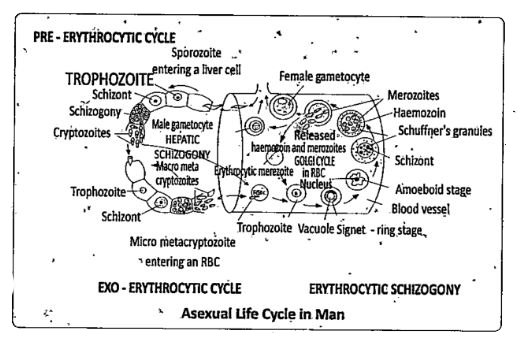Describe the life cycle of Plasmodium vivax in human with a neat labelled diagram.
Life cycle of Plasmodum in man (The human phase): In man, the Plasmodium reproduces by asexual reproducton called schizogony. It occus in liver cells (hepatocytes) as well as in RBC. In liver cells, it is called hepatic, schizogony and in RBC it is called erythrocytic schizogony.
Hepatic schizogony: This was discovered by Shortt and Garham. Whenever a mosquito infected by Plasmodium bites a man, nearly 2000 sporozoites are released into the blood of man through it saliva. Within half an hour, they reach the hepatocytes where they undergo pre-erythrocytic and exoerythrocytic cycles. Pre-erythrocytic cycle: Whenever the sporozoites reach the liver cells, they transform into trophozoites. They feed on the contents of the heaptic cells, assume spherial shape and attain the maximum size. this stage is called schizont stage. It nucleus divides several times mitotically followed by the cytoplasmic divisions resulting in approximately 12,000 daughter individuals called cryptozoites or the 1st generation merozoites. They enter the sinusoids of the liver by rupturing the cell membrane of the schizont and the liver cells. The entire process is completed approximately in 8 days. Now these first generation merozoites have two options ie. , they can enter either fresh liver cells and continue exo-erythrocytic cycle or they can enter RBC and continue erythracytic cycle.
Exo-erythrocytic cycle: If the cryptozoits enter the fresh liver cells, they undergo the changes similar to that of the preerythrocytic cycle and produce the second generation merozoites called metacryptozoites. These are of two types the smaller micro metaryptozoites and larger macro metacryptozoites.
The entire process is completed approximately in two days. The macro metacrptozoites attack fresh liver cells and continue another exo-erythrocytic cycle, whereas the micrometacryptozoites always enter blood stream and attack fresh RBC to continue erythrocytic cycle.
Prepatent period: The interval betwen the first entry of Plasmodium into the blood in the form of sporozoites and the second entry of Plasmodium into the blood in the form of cryptozoites is called prepatent period. It lasts approximately 8 days. During this period, the host does not show any clinical symptoms of the disease. it is only a meas of multiplication.
Erythrocytic cycle: It was first described by Camillo Golgi. Hencce it is also called Goige Cycle: This cycle is initiated either by the cryptozoites fo pre -erytrocytic cycle or the micro metacryptozoites of exo erythrocytic cycle. In the fresh RBC,these stages assume spherical shape and transform into trophozoites. It deveops a small vacuole which gradually enlarges in size, pushing the cytoplams and nucleus to the periphery. Now the Plasmodium looks like a finger ring. Hence thsi stage is called sigment ring stage. Soon it loses the vacuole, develops pseudopodia and becomes amoeboid stage. WIth the help of pseudopodia, it actively feeds of the contents of the RBC and increases in size. This process is called hypertrophy. The malaria parasite digests the globin part of the ingested haemoglobin and conerts the soluble haem into an insoluble crystalline haemozoin. It is called the malaria pigment which is a disposable product. During this stage, small red coloured dots appear in the cytoplams of the RBC known as SChuffner s dots. These are believed to be the antigens released by the parasite. Now the Plasmodium loses the pseudopodia, further increases in size, occupies the entire RBC and becomes a schizont. It undergoes schizogony similar to that of the pre erythrocytic cycle and produces 12 to 24 erythrocytic merozoites. They are arranged in the form of the petals of a rose in the RBC. Hence, this stage is called the rosette stage. Finally the erthrocyte bursts and released the merozoites along with haemozoin into blood. This cycle is completed approximately in 48 hours.
Incubation Period: The priod between teh entry of Plasmodium into the blood in the form of sporozoite and the first appearance of symptoms of malaria in man. is called incubation period. It is approximately 10 to 14 days.
Formation of gametocytes: After repreated cycles of erythrocytic schizogony, when the number of fresh RBC decreases, some merozoites enter the RBC and transfrom into gametocytes instead of continuing the erythrocytic cycle. This process generally takes place when the RBCs are present in spleen and bone marrow.
The gametocytes are of two types namely, smaller microgametocytes or male gametocytes and larger macrogametocytes or female gametocytes. The gametocytes cannot undergo further development in man as the temperature and pH of the blood of man are not suitable for further development. These gametocytes reach the blood circulation and wait to reach th enext host. THey degenerate and die if they are not rransferred to mosquito within a week.

Related Playlists
Similar Questions
Describe the life cycle of Plasmodium vivax, the causative agent of malaria.
View SolutionDescribe the biogas plant with a neat labelled diagram.
View SolutionDescribe the electrolytic reduction of alumina with neat labelled diagram
View SolutionDescribe the construction and working of a transformer with a neat labelled diagram
View SolutionDescribe the mechanism of translation with the help of neat and labelled diagram.
View SolutionDescribe the structure of human female reproductive system with a neat labelled diagram
View SolutionIn the life cycle of Plasmodium vivax, schizogony occurs in these cells of man (a) Hepatocytes (b) Adipocytes (c) Erythrocytes (d) Reticulocytes
View SolutionIn the life cycle of Plasmodium vivax, shizogony occurs in these cels of man (a) Hapatocytes (b) Adipocytes (c) Erthrocytes (d) Reticulocytes
View SolutionDescribe the asexual and sexual phases of life cycle of Plasmodium that causes malaria in humans.
View SolutionDescribe the asexual and sexual phases of life cycle of Plasmodium that causes malaria in humans.
View Solution

